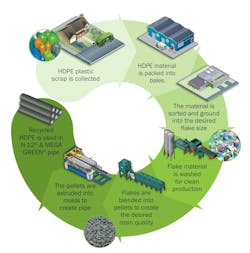Storm Drain Pipes: Pipe Evolution
Daniel J. Figola is director of sustainability development for Advanced Drainage Systems Inc. Figola can be reached at [email protected].
undefinedThere are few industries today that do not feel the pressure to create more sustainable processes and products. Investors, regulators and the general public are calling for us to innovate in ways that improve environmental outcomes and allow communities to withstand the effects of climate change.
The idea of a circular economy is no longer new. Reducing or eliminating waste by incorporating used materials, such as plastics, into new products and applications is part of the every day sustainability conversation.
At the same time, these products need to be of high quality and able to withstand the rigors of use. In other words, they must be resilient.
The storm water management industry has a huge opportunity to incorporate circular and resilient systems into our nation’s infrastructure. While the acceptance of recycled materials in non-residential drainage pipe has been slow to come, recent developments are helping it gain acceptance. These include standards for resilient systems and standards that accept recycled materials in infrastructure.
Envisioning the Future
First, resilient design allows buildings, landscapes, communities and regions to adapt to or remain functioning during changing environmental conditions. We need buildings and systems–including storm water solutions–to be adaptable and durable while optimizing the use of local and regional resources.
As we look to design systems that can resist extreme events and climate change, we need to ensure they have the least negative impact possible on the environment. Many view resiliency and sustainability as separate items, but they should be interconnected. That is the mission of the Envision Program, a design and rating system for infrastructure, which is focused on sustainability and resiliency.
As much as the LEED program redefined vertical building construction more than a decade ago, Envision is redefining how our industry plans and constructs infrastructure and community projects.
In 2011, the industry came together to establish the Institute for Sustainable Infrastructure (ISI) to help civil engineers measure the sustainability of infrastructure projects. ISI then worked with the Zofnass Program for Sustainable Infrastructure at the Harvard University Graduate School of Design to develop the Envision Program.
Storm water management design has a major role to play in building resilient and sustainable infrastructure, and developers are increasingly being asked to incorporate Envision standards into their processes.
Meanwhile, our industry is beginning to realize other opportunities to achieve a circular economy that goes beyond resiliency. According to the Association of Plastic Recyclers, the plastic drainage pipe industry uses more non-food grade HDPE (high-density polyethylene) from households than any other entity. We also use a lot of food-grade HDPE.
These are the shampoo and detergent bottles, the milk and juice jugs we all use in our homes. The containers are optimal recycling materials for HDPE drainage pipe. First of all, the color of recycled plastic does not matter, since the end product is black. Blending allows for use of materials with a wide range of properties. Most residual odors dissipate through the product process, but if a small amount remains, nobody cares if their drainage pipe smells a little like fabric softener.
While recycled plastics have for years been used in residential drainage pipe applications, highway construction standards have presented roadblocks to their use in transportation projects. Fortunately, those who set industry standards are recognizing the science that proves greener products can meet quality standards, improve resiliency and help take plastics out of the waste stream.
Currently, many pipe products, such as agricultural and highway drainage pipes, are produced to historical national ASTM (formerly American Society for Testing and Materials) and ASSHTO (American Association of State Highway and Transportation Officials) standards. Not all of these standards allow for use of recycled materials. Several years ago, a National Cooperative Highway Research Program study examined the use of recycled material in HDPE pipe. The results showed that service life for drainage pipe with recycled materials can be 100 years or more, and these findings prompted AASHTO to allow recycled materials in highway drainage pipe.
Because all 50 states look to AASHTO for guidance on acceptable standards for highway construction, this was a turning point. As a result, more than half of states now accept the use of recycled plastic in drainage pipe used in highway construction.
Taking single-use plastics and converting them to products that will last a century or more has significant ramifications for our nation’s crumbling infrastructure and our bulging landfills. While offering recycled materials can provide competitive benefit on some projects where sustainability is part of a project’s design philosophy, it also helps move us closer to a circular economy. Most importantly, it gives our industry a chance to lead on issues regarding sustainability, resiliency and the environment. Because we are no longer tasked with only storm water solutions but with innovating toward a common, sustainable future.


